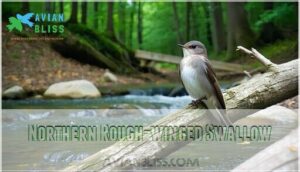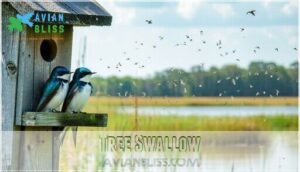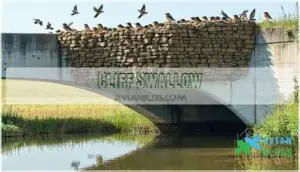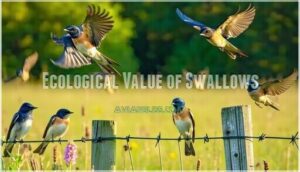This site is supported by our readers. We may earn a commission, at no cost to you, if you purchase through links.

The Barn Swallow’s deeply forked tail and rusty underparts make it unmistakable, while Purple Martins are your largest swallows with their glossy blue-black plumage.
Tree Swallows sport clean white bellies and iridescent backs, and Northern Rough-winged Swallows show brownish throats without the crisp white of their cousins.
Cliff Swallows build their gourd-shaped mud nests in colonies, and Bank Swallows dig burrows in sandy banks.
These aerial acrobats share similar hunting techniques but occupy different niches across the state’s diverse habitats, from coastal marshes to mountain meadows.
Table Of Contents
- Key Takeaways
- Types of Swallows in North Carolina
- Barn Swallow
- Northern Rough-winged Swallow
- Purple Martin
- Tree Swallow
- Cliff Swallow
- Bank Swallow
- Natural History of Swallows
- Ecological Value of Swallows
- Preventing Human and Swallow Conflicts
- Frequently Asked Questions (FAQs)
- Are there swallows in North Carolina?
- How to tell the difference between a swift and a swallow?
- Why are swallows flying around my house?
- When do swallows migrate to North Carolina?
- How long do swallows live in captivity?
- Can swallows be kept as pets legally?
- What diseases do swallows commonly carry?
- How do weather patterns affect swallow populations?
- Conclusion
Key Takeaways
- You’ll identify six distinct swallow species in North Carolina by focusing on key field marks like tail shape, coloration, and habitat preferences—from the Barn Swallow’s deeply forked tail to the Purple Martin’s glossy blue-black plumage.
- You can’t legally disturb active swallow nests under the Migratory Bird Treaty Act, so you’ll need to wait until young birds fledge before removing nests or installing deterrents during winter months.
- You’ll find these aerial insectivores provide exceptional ecological value by consuming up to 60% of their body weight in insects daily, making them nature’s most efficient pest control specialists.
- You’ll spot different species in their preferred habitats—Barn Swallows near human structures, Tree Swallows around water bodies, and Bank Swallows along riverbanks with vertical banks for burrow excavation.
Types of Swallows in North Carolina
North Carolina’s summer skies come alive with six distinct swallow species, each bringing unique characteristics to our state’s diverse ecosystems.
These aerial insectivores include the widespread Barn Swallow that adapts to human structures, the water-loving Northern Rough-winged Swallow, and the colonial Purple Martin.
You’ll also spot Tree Swallows near freshwater bodies, cliff-dwelling Cliff Swallows in open country, and the increasingly rare Bank Swallow.
Swallow identification relies on key field marks like tail shape, coloration, and habitat preferences.
Their nesting habits vary dramatically—from solitary cavity nesters to colonial mud-builders.
From expert craftsmen to endless design options—swallows master both solo artistry and teamwork when building their homes.
Their agile flight allows them to capture insects mid-air.
Migration patterns bring these NC birds here seasonally, though conservation status varies by species.
Understanding these types of swallows enhances your birding experience while supporting their protection through informed observation.
Barn Swallow
The Barn Swallow stands as North Carolina’s most recognizable swallow species, enchanting birders with its distinctive forked tail and glossy blue upperparts.
You’ll spot these aerial acrobats measuring 7 inches long with 12-13 inch wingspans, showcasing reddish-brown foreheads and throats that make Barn Swallow ID straightforward.
Their nesting habits center around human structures—barns, bridges, and building eaves become prime real estate for their cup-shaped mud nests lined with grass.
These swallows demonstrate remarkable site fidelity, often reusing and repairing nests annually.
Key identification features include:
- Deeply forked tail distinguishing adults from juveniles
- Iridescent blue-black upperparts contrasting with buff underparts
- Agile flight patterns while capturing insects mid-air.
Their foraging behavior focuses on daylight hunting, capturing flies and beetles through spectacular aerial maneuvers.
Migration patterns take these North Carolina swallows to Central and South America each winter, returning April through August for breeding season.
Despite their conservation status remaining stable globally, habitat loss threatens some regional populations; similarly, the barn owl faces threats due to habitat loss and pesticide use.
Northern Rough-winged Swallow
Looking beyond the barn swallow’s familiar presence, you’ll discover the Northern Rough-winged Swallow offers a more subtle birding experience.
This brown-backed species gets its name from tiny hooks on its wing feathers, though you’ll need close observation to notice this feature. Watch for their distinctive foraging behavior as they hunt low over water surfaces, catching insects with impressive precision.
Northern Rough-winged Swallow Quick Guide
| Feature | Details |
|---|---|
| Identification Tips | Brown upperparts, white underparts, square tail |
| Habitat Preference | Streams, rivers, bridges, rocky areas |
| Nesting Cavities | Banks, cliffs, abandoned burrows, bridge crevices |
| Conservation Status | Stable populations, least concern classification |
These North Carolina swallows prefer solitary nesting over colonial behavior. You’ll find them occupying natural cavities or appropriating old kingfisher burrows along waterways.
Their habitat preference for riparian areas makes them excellent indicators of healthy stream ecosystems, contributing substantially to insect control in wetland environments. They’re known to nest from sea level upwards to 9,000 feet.
Purple Martin
Purple Martin colonies are a sight to behold in North Carolina, with males flashing iridescent blue-purple and females showing softer gray.
As the largest of all types of swallows here, Purple Martins depend on Martin Housing for nesting, often forming large groups near lakes or marshes.
Their agile flight and bubbling calls are unmistakable during daylight insect hunts—diet analysis shows they consume beetles, dragonflies, and mosquitoes, helping keep pest numbers down.
Migration routes stretch from South America to North Carolina, with birds arriving in late March and departing by early September.
Populations are declining due to habitat loss and urban expansion.
Due to habitat loss and competition, their conservation status is a concern, and effective colony management and increased awareness can help guarantee this bird species remains a local treasure.
Tree Swallow
Tree Swallows, with their iridescent feathers and swift aerial moves, are a staple of wetland habitat in North Carolina.
These swallows stand out for their willingness to use nesting boxes, helping boost increasing populations, especially with southern breeding trends.
For bird identification, watch for their greenish-blue backs and white underparts.
One similar species, the Northern Rough-winged Swallow, exhibits serrated wing edges for agile flight.
Here’s what sets them apart:
- Readily accept artificial nesting boxes
- Prefer open fields near water
- Form loose colonies, not dense clusters
- Feed on flying insects mid-air
- Signal healthy swallow habitat
Cliff Swallow
Among the types of swallows in North Carolina, the Cliff Swallow stands out for its colonial nesting habits and impressive mud nests. You’ll often find these swallows in large groups, building gourd-shaped nests under bridges, eaves, and other man-made structures.
Their rusty-red foreheads and dark blue backs make them easy to spot as they swoop over open fields and ponds, catching flying insects mid-air. These colonies can grow to hundreds of nests, providing safety in numbers from predators like hawks and snakes.
Cliff Swallows migrate thousands of miles to wintering grounds in South America, returning to North Carolina in spring. Their population expansion is closely tied to the availability of suitable swallow habitat, especially near water.
However, habitat loss and pesticide use threaten their numbers. Protecting nesting sites and monitoring colonies are essential for their conservation. Listed as Least Concern, the species still faces threats such as competition from invasive species, impacting local populations.
Under the Migratory Bird Treaty Act, disturbing active nests is prohibited, ensuring these acrobatic swallows remain a summer staple.
Bank Swallow
You’ll recognize the Bank Swallow by its distinctive brown chest band and smaller size compared to other North Carolina swallows.
This aerial insectivore excavates burrows in vertical riverbanks, creating colonial nesting sites that offer protection from predators.
Unfortunately, habitat loss from construction and riverbank modifications has contributed to significant population decline across their range.
Bank Swallows capture flying insects during peak feeding times in early morning and late afternoon, making them valuable for natural pest control.
Conservation efforts focus on protecting existing nesting colonies and monitoring population trends.
These indicator species reflect the health of riparian ecosystems, and their presence signals quality habitat conditions throughout North Carolina’s waterways.
They’re known to be colonial nesters, sometimes forming colonies of up to 2,000 nests.
Natural History of Swallows
Swallows exhibit fascinating natural history patterns that make North Carolina birders take notice throughout the year.
These aerial acrobats demonstrate remarkable flight patterns, executing precise maneuvers while hunting insects on the wing.
Their swallow diet consists almost entirely of flying insects caught during daylight hours, with each bird consuming thousands daily.
Nesting habits vary dramatically between species—some excavate burrows, others construct elaborate mud structures, while cavity-nesters readily accept human-provided boxes.
Social behavior ranges from solitary pairs to massive colonial gatherings of hundreds.
Most North Carolina swallows migrate seasonally, connecting local ecosystems to distant wintering grounds.
Lifespan typically spans 4-8 years, though banding studies reveal some individuals exceed a decade.
Understanding swallow identification requires observing their unique combination of habitat preferences, range distributions, and behavioral traits that distinguish each species across the state.
They also serve as nature’s pest control, consuming thousands of insects daily.
Ecological Value of Swallows
Beyond their distinctive flight patterns and nesting behaviors, swallows deliver remarkable ecological value that extends far beyond what you might expect from these small aerial acrobats.
Their contributions to ecosystem health make them indispensable allies in maintaining balanced environments across North Carolina’s diverse landscapes.
Swallows function as nature’s most efficient pest control specialists, with each bird consuming up to 60% of its body weight in insects daily.
Nature’s ultimate pest control army: each swallow devours 60% of its body weight in insects daily.
This translates to thousands of flying pests eliminated per day, substantially reducing agricultural damage and disease-carrying mosquito populations.
Their impact on ecosystem health includes:
- Insect control – Target agricultural pests like aphids and beetles, reducing crop damage
- Nutrient transport – Distribute nitrogen and phosphorus through guano, fertilizing soils
- Indicator species – Reflect environmental quality through population trends
- Seed dispersal – Inadvertently spread plant seeds during foraging activities
- Pollination support – Visit flowers for nectar, transferring pollen between plants
These aerial insectivores serve as living barometers of environmental health, with declining populations often signaling pesticide overuse or habitat degradation.
They’re similar to swallows in Wisconsin, which also contribute to pest control.
Their presence indicates thriving wetlands and productive agricultural systems.
Preventing Human and Swallow Conflicts
While timing is everything in preventing human-swallow conflicts, understanding their nesting habits makes coexistence much easier.
You can’t legally remove active nests under the Migratory Bird Treaty Act, so Legal Considerations require waiting until young fledge before cleaning or repairs.
Deterrent Methods like bird spikes, netting, and visual deterrents work best when installed before spring arrival. Habitat Modification involves removing old nests and mud traces during winter months to discourage reuse.
Feces Management becomes essential near nesting sites—frequent washing and placing newspaper below nests helps with cleanup costs. Smart Nest Removal timing prevents nuisance prevention issues while respecting federal protections.
Installing bird deterrents on ledges and eaves before breeding season starts gives you the upper hand. Remember, swallows return to familiar sites annually, so early prevention beats reactive measures every time.
Consider providing clean water to further encourage swallows to use designated areas away from human structures.
Frequently Asked Questions (FAQs)
Are there swallows in North Carolina?
Yes, you’ll find multiple swallow species throughout North Carolina.
These aerial acrobats include Barn Swallows, Tree Swallows, Purple Martins, Cliff Swallows, Northern Rough-winged Swallows, and the increasingly rare Bank Swallow, all protected under federal law.
They are protected under federal law, which applies to all these species.
How to tell the difference between a swift and a swallow?
You’ll spot swifts by their curved, scythe-like wings and constant flight—they can’t perch like swallows. Swallows have broader wings, forked tails, and frequently rest on wires.
Why are swallows flying around my house?
Each swallow consumes thousands of flying insects daily, making them nature’s pest control experts.
They’re likely hunting the abundant insects around your home, especially if you have outdoor lights, water sources, or gardens that attract flying bugs.
When do swallows migrate to North Carolina?
Most swallow species arrive in North Carolina during spring migration, typically between March and May, depending on the species and weather conditions affecting their northward journey.
How long do swallows live in captivity?
Like a caged songbird trading endless skies for prison bars, you’ll find swallows don’t thrive in captivity.
These aerial acrobats aren’t suited for confined spaces, making captive lifespans substantially shorter than their natural 4-8 year lifespan in the wild.
Can swallows be kept as pets legally?
No, you can’t legally keep swallows as pets in the United States.
The Migratory Bird Treaty Act of 1918 protects all swallow species, making it illegal to capture, possess, or transport them without federal permits.
What diseases do swallows commonly carry?
While you might see swallows as harmless aerial acrobats, they can harbor salmonella, West Nile virus, and various parasites like mites and fleas that pose health risks to humans.
How do weather patterns affect swallow populations?
Weather patterns substantially impact swallow populations through food availability, nesting success, and migration timing.
You’ll notice fewer swallows during cold, wet springs when insects are scarce, affecting breeding success and survival rates.
Conclusion
Mastering identification of these swallows in North Carolina will transform your birding experience forever! Each species occupies distinct ecological niches across the state’s varied landscapes, from coastal wetlands to mountain valleys.
You’ll find barn swallows near agricultural areas, purple martins in open spaces, and tree swallows around water bodies. Bank and cliff swallows prefer specific nesting sites, while rough-winged swallows adapt to diverse habitats.
Understanding their behavioral patterns, seasonal movements, and preferred environments enhances your field identification skills substantially.
- https://badgerlandbirding.com/2023/09/28/swallows-of-north-carolina-7-species-to-know/
- https://ncbirds.carolinabirdclub.org/view.php?species_id=389
- https://nc.audubon.org/news/win-win-research-and-conservation
- https://www.audubon.org/field-guide/bird/barn-swallow
- https://www.youtube.com/c/BadgerlandBirding










